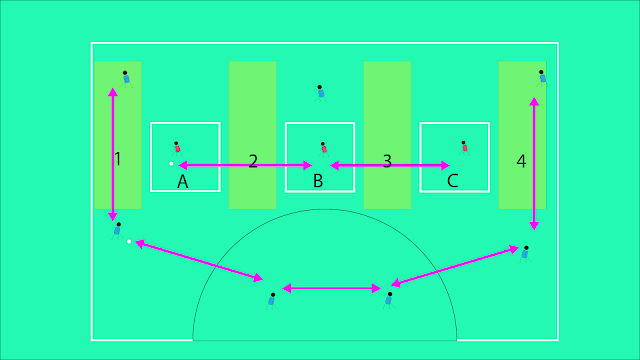Outletting
Outletting Drill
Setup
- Arrange the drill as shown in the accompanying diagram.
Field Layout
- Boxes: A, B, and C represent different areas where the press operates.
- Seams: 1, 2, 3, and 4 are pathways for breaking the press.
Objective
- The goal is to pass the ball from one end of the field to the other, controlling it within each box before moving it on.
- When the ball reaches Box A or C, the receiving player should stop the ball and has the option to step out of the box to protect Seam 1 or 4 respectively.
- If a forward pass is not feasible, the defensive unit may reverse the ball to the opposite seam. However, each defensive player must make contact with the ball during this play.
Scoring
- The Press earns 5 points for intercepting the ball.
- The Defensive Unit scores 5 points for successfully passing the ball through Seam 1 or 4 with the receiver controlling the pass.
Progression
- Introduce decision-making elements into the game to enhance strategy.
- Defensive players are no longer required to pass the ball to every teammate. Instead, they can exploit opportunities to pass through Seams 2 or 3.
- If a pass through Seam 2 or 3 is successfully received by a midfielder, the defensive unit scores 10 points.
- Press players who are not in possession of the ball can leave their designated Box to defend Seams 2 or 3.
This structured approach should help players understand the game mechanics and the roles of different positions more clearly.
Breaking the press in field hockey is a tactical manoeuvre used by the team with the ball to overcome the opposition's defensive strategy, which is aimed at restricting the space and passing options of the ball-carrying team. The main objectives of breaking the press include:
Maintaining Possession: Safely navigating the ball through tight defensive setups to maintain control and prevent turnovers.
Creating Space: By successfully breaking the press, teams can open up the field, creating more space for players to operate. This space allows for more effective ball movement and can disrupt the defensive alignment of the opposing team.
Advancing the Ball: The ultimate goal is to move the ball forward towards the opposition's goal. Breaking the press effectively helps in transitioning from defence to attack, setting up opportunities to score.
Relieving Pressure: By breaking the press, the team alleviates the intense pressure put on by the opposition, helping to reduce the risk of errors that can occur under stress and potentially lead to conceding goals.
Exploiting Weaknesses: Effective breaking of the press can expose gaps or weaknesses in the opposition's defence, which can be exploited for offensive gains.
Improving Game Flow: Successfully circumventing the press can help establish a rhythm and flow to the game, allowing for smoother transitions and more dynamic play.
Each of these objectives contributes to a strategic approach in field hockey, aiming to turn defensive moments into offensive opportunities and maintain control over the game's tempo and direction.





Comments
Post a Comment